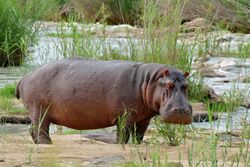Biology:Megaherbivore
Megaherbivores (Greek μέγας megas "large" and Latin herbivora "herbivore") are large terrestrial herbivores that can exceed 1,000 kg (2,200 lb) in weight. This polyphyletic group of megafauna includes elephants, rhinos, hippos, and giraffes.[1]:1[2][3](p524) The largest bovids (gaurs and American bisons) occasionally reach a weight of 1 tonne (1.1 short tons), but they are generally not considered to be megaherbivores.[1](p14) There are nine extant species of megaherbivores living in Africa and Asia.[3][4] The African bush elephant is the largest extant species with bulls reaching a height of up to 3.96 m (13.0 ft) and a maximum weight of 10,400 kg (22,900 lb).[5]
All megaherbivores are keystone species in their environment. Their ecological role is to change the vegetative structure through feeding behavior, and seed dispersal.[6] Megaherbivores like most large mammals are K-selected species.[7] They are characterized by their large size, invulnerability to predators, their impact on vegetation and their dietary tolerance.[8] Megaherbivores have been around for over 300 million years, but they are now extirpated from much of their historic range.[9]
Species
This is a list of all nine extant species of megaherbivores, with a brief description for each.
| Common name | Image | Description |
|---|---|---|
| African bush elephant (Loxodonta africana) | 
|
The African bush elephant, also known as the Savanna elephant is one of three members of the family Elephantidae, in which it is the largest member.[5] They are native to a large part of sub-Saharan Africa.[10] They are characterized by their by their large size, huge ears, a long trunk with two finger-like processes and large ivory tusks.[11](p124) [12] |
| Asian elephant (Elephas maximus) | 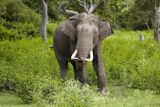
|
The Asian elephant also known as the Asiatic elephant is the second largest elephant species native to the Indian subcontinent and Southeast Asia.[13] Its back is convex and its ears are relatively small compared to African elephants. The trunk has one finger-like processing and contains over 60,000 muscles and males are the ones who often grow tusks.[14] |
| African forest elephant (Loxodonta cyclotis) | 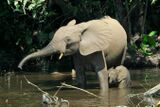
|
The African forest elephant is the smallest species of elephants. It is native to West Africa and the Congo Basin. It is one of two species of African elephants, the other being the African bush elephant.[15] Its trunk has two finger-like processes and contains about 40–60,000 muscles.[16] It has tusks that grow to 1.5 m (4 ft 11 in) long and weigh 23–45 kg (51–99 lb).[17] |
| White rhinoceros (Ceratotherium simum) | 
|
The white rhinoceros sometimes called the white rhino or square-lipped rhinoceros is a large rhinoceros native to sub-Saharan Africa.[18] The largest extant rhino species, it has two horns with the front horn growing up to 101 cm (40 in).[19](p31) It has a visible hump on the back of the neck. Despite their size they can run at speeds of 50 km/h (31 mph).[20] |
| Indian rhinoceros (Rhinoceros unicornis) | 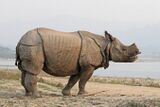
|
The Indian rhinoceros also known as the Indian rhino, greater one-horned rhinoceros or great Indian rhinoceros, is the second largest extant rhinoceros native to the Indian subcontinent.[21] It has one horn that grows to a length of about 25 cm (9.8 in).[22](pp59-61) It is the second largest land mammal native to Asia, after the Asian elephant.[23][page needed] |
| Hippopotamus (Hippopotamus amphibius) | 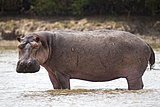
|
The hippopotamus also known as the hippo, common hippopotamus or river hippopotamus is a large mammal native to sub-Saharan Africa. It is semiaquatic and spends most of its time resting in water.[24] They have large canines up to 50 cm (20 in) long and their incisors can grow to 40 cm (16 in).[25](p222) They have a large barrel-shaped torsos, with pillar-like legs and nearly hairless bodies. They can run at 30 km/h (19 mph) in spite of their size. |
| Black rhinoceros (Diceros bicornis) | 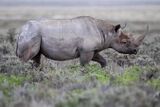
| |
| Javan rhinoceros (Rhinoceros sondaicus) | 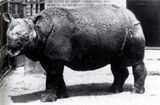
|
The Javan rhinoceros, Javan rhino, Sunda rhinoceros or lesser one-horned rhinoceros, is a very rare rhinoceros species. With only 74 individuals left, it is critically endangered and only survives in one place, the Ujung Kulon National Park in western Java.[26] Only bulls have horns that grow up to 27 cm (11 in). |
| Giraffe (Giraffa camelopardalis) | 
|
The giraffe is a large ruminant native to sub-Saharan Africa.[27] It is the tallest terrestrial animal and has extremely long neck and legs. The neck can grow up to 2.4 m (7 ft 10 in).[28] Male and female giraffes both have horn-like structures called ossicones, which in males can reach 13.5 cm (5.3 in).[29] |
Ecology
Elephants are mixed feeders, giraffes and Javan rhinos are browsers, while white and Indian rhinoceroses are true grazers.[30] Megaherbivores consume graminoid, which are dicotyledon proportions which also includes non-graminaceous monocots with dicots. They prefer eating the foliage, stemmy material and fruits of the plant. Elephants and rhinos exhibit hindgut fermentation while giraffes, like all bovids are ruminants with foregut fermentation. Hippos display foregut fermentation but they lack the distinctly divided section and remastication that are typical in ruminants.[1](p16)
Due to their size, megaherbivores can defoliate the landscape. Because of this they are considered keystone species in their environment.[31] They use their size, power and feeding behavior to change the structure and composition of vegetation, which affects both the recycling and spread of nutrients, as well as the climate. Megaherbivores can create open landscapes at the cost of forested ones through feeding behavior which over time clears vegetation. They also spread more seeds over a larger distance than smaller frugivores, this then changes the shape of the forested area. As a result, they significantly impact the composition of the species in the ecosystems in which they inhabit.[9]
Their size also causes a slow metabolic rate, which then causes food to be processed in their gut at a leisurely pace. This slow passage through the gut gives time for the disintegration of a high fiber diet and allows natural processing of plant components through microbial activity.[2]
Because of their size, thick skin (up to 5 cm (2.0 in) in some places) and vast muscular power, megaherbivores are immune to predation, as no predators regularly hunt adult elephants, rhinoceroses or hippopotamuses. Giraffes on the other hand are susceptible to predation in areas such the Kruger National Park where its not uncommon for lions to prey on adult giraffes.[2][32]
Evolution
Megaherbivores were present in earth's terrestrial ecosystems ever since the early Permian (300 mya).[33] The taxonomic structure of megaherbivores switched through time. The first megaherbivores were mammal-like reptiles that lived from the late Palaeozoic to the early Triassic (200 mya). The taxonomic composition then switch to sauropsids.[34] These replacements roughly happen at the same time with changes in the dominant plant groups, or with mass extinction events. Sometimes new megaherbivore groups outcompete previous groups, in other cases animals that did not originally belong to megaherbivores adopt the ecological niche of the previously dominant but now extinct megaherbivore taxa.[33][35]
Before the Cretaceous-Paleogene mass extinction, all species of megaherbivores were dinosaurs since the late Triassic.[36] The Cretaceous-Paleogene mass extinction (around 66 mya) is the best-known megaherbivore replacement that caused the extirpation of all megaherbivore dinosaurs and the divergence of large herbivorous mammals that evolved from species incomparable in size.[37][38] Following the extinction of the whole late Cretaceous megaherbivore guild, the evolution of new taxa from different guilds took place. Roughly 10 million years after the mass extinction, mammals attained body sizes of megaherbivores on all continents.[39] There were at least one species of megaherbivore in all continents and in all climates, during cenozoic times and also the Pleistocene before the arrival of modern humans.[40]
The Quaternary Extinction event is an event where many species of megafauna (particularly mammals) went extinct as part of a global, diachronous extinction event. This events caused the disappearances of megaherbivores in most continents on Earth.[41] There were at least 50 species of megaherbivore in the Late Pleistocene. There were about 16 species of Proboscia (elephants, mammoths, etc.), 7 species of Cetartiodactyla (bovids, hippopotamus, camels), 9 species of perissodactylans (rhinoceros), 5 Cingulata (glyptodonts) species, 8 Pilosa (giant sloths) species, 3 Notoungulata (toxodonts) species, and a single species from Liptoterna and Diprotodontia. Today, only nine of the 50 species remain. The Americas saw the worst decline in megaherbivores, losing all 27 species.[9] Climate change and the arrival of humans could be the cause of the extinctions.[42]
Adaptions and size
Megaherbivores exhibit the following adaptive syndrome: They are tolerant feeders and despite there only being nine extant species of megaherbivores, they comprise nearly half of the large herbivore biomass. Adults are invulnerable to predation and populations are relatively not affected by droughts. Megaherbivores also have a big impact on vegetation.[43][44]
Size
In terms of size and weight, megaherbivores are divided into four clusters:[1](p14)
- Cluster i – elephants: 2,500–6,000 kg (5,500–13,200 lb)
- Cluster ii – white rhinos, Indian rhinos and hippos: 1,400–2,300 kg (3,100–5,100 lb)
- Cluster iii – black rhinos and Javan rhino: 1,000–1,300 kg (2,200–2,900 lb)
- Cluster iiii – giraffe: 800–1,200 kg (1,800–2,600 lb)
Reproduction and longevity
Reproduction
Megaherbivores are k-selected species, meaning they have high lifespans, slow population growth, large offspring, long gestation periods, slow maturation, low mortality rates and no natural predators.[45]
Females in estrous change in behaviour and physiology. This causes males to exhibit courtship behaviors, which then progresses to copulation. Breeding access may be influenced by the dominance relationships between males. Rhinos and hippos copulate for an extended period of time, while elephants and giraffes copulate briefly. Females have long gestation periods between 8 and 22 months. Intervals between births vary between species but the overall range is 1.3 to 4.5 years.
They usually give birth to a single calf. During the early stages of life, neonatals are totally dependent on their mothers for food and protection. As they get older, the calf starts weaning while still suckling. When they reach juvenility, they become less dependent on their mothers for food and protection. Juvenility typically ends when the mother chases her offspring, however in a few species adolescents may associate themselves with their mothers.[1](pp116-124 and 133)
Lifespan and mortality
Megaherbivores have high life expectancies. The potential lifespan of a hippopotamus or rhinoceros is around 40 years, while that of an elephant is around 60 years.[32] Giraffes have a potential lifespan of 25 years.
Megaherbivores exhibit a low mortality rate from natural causes as they reach adulthood, about 2 to 5% per annum. Males have higher mortality rates due to injuries from fights. Giraffes are the only species who are at risk to significant predation. Severe droughts can cause occasionally high mortality rates, especially with calves.[1](p158)
See also
- Australian megafauna
- Deep-sea gigantism
- Largest and heaviest animals
References
- ↑ 1.0 1.1 1.2 1.3 1.4 1.5 Owen-Smith, R. Norman (1988) (in en). Megaherbivores: The Influence of Very Large Body Size on Ecology. Cambridge University Press. ISBN 978-0-521-42637-4. https://books.google.com/books?id=1jT72JdLVIcC&q=megaherbivores.
- ↑ 2.0 2.1 2.2 Ray, Justina; Redford, Kent H.; Steneck, Robert; Berger, Joel (2013-04-09) (in en). Large Carnivores and the Conservation of Biodiversity. Island Press. pp. 87. ISBN 978-1-59726-609-3. https://books.google.com/books?id=ndb0QOvq2LYC&dq=megaherbivores&pg=PA87.
- ↑ 3.0 3.1 (in en) 'Wildlife' Review. U.S. Department of the Interior, Fish and Wildlife Service. 1989. https://books.google.com/books?id=XcJGAQAAMAAJ&dq=Megaherbivores&pg=PA524.
- ↑ Wells, Harry B. M.; Crego, Ramiro D.; Opedal, Øystein H.; Khasoha, Leo M.; Alston, Jesse M.; Reed, Courtney G.; Weiner, Sarah; Kurukura, Samson et al. (2021). "Experimental evidence that effects of megaherbivores on mesoherbivore space use are influenced by species' traits" (in en). Journal of Animal Ecology 90 (11): 2510–2522. doi:10.1111/1365-2656.13565. ISSN 0021-8790. PMID 34192343.
- ↑ 5.0 5.1 Larramendi, A. (2016). "Shoulder height, body mass and shape of proboscideans". Acta Palaeontologica Polonica 61 (3): 537–574. doi:10.4202/app.00136.2014. ISSN 0888-8892. https://www.app.pan.pl/archive/published/app61/app001362014.pdf.
- ↑ Collett, Jonathan; Karakashian, Stephen (2013-04-10) (in en). Greening the College Curriculum: A Guide To Environmental Teaching In The Liberal Arts. Island Press. ISBN 978-1-61091-080-4. https://books.google.com/books?id=IbLWvJ2mZecC&dq=Vegetation%2C+Megaherbivores%2C+Man+and+Climate+in+the+Quaternary+and+the+Genesis+of+Closed+forests&pg=PA115.
- ↑ "r and K selection". https://www.bio.miami.edu/tom/courses/bil160/bil160goods/16_rKselection.html.. University of Miami Department of Biology. Retrieved February 4, 2011
- ↑ Owen-Smith, Norman (1989). "The megaherbivore syndrome: alternative life style or different time frame?". in Bruton, Michael N. (in en). Alternative Life-History Styles of Animals. Dordrecht: Springer Netherlands. pp. 441–457. doi:10.1007/978-94-009-2605-9_22. ISBN 978-94-009-2605-9.
- ↑ 9.0 9.1 9.2 Bocherens, Hervé (2018). "The Rise of the Anthroposphere since 50,000 Years: An Ecological Replacement of Megaherbivores by Humans in Terrestrial Ecosystems?". Frontiers in Ecology and Evolution 6. doi:10.3389/fevo.2018.00003. ISSN 2296-701X.
- ↑ Gobush, K.S.; Edwards, C.T.T; Balfour, D.; Wittemyer, G.; Maisels, F.; Taylor, R.D. (2021). "Loxodonta africana". IUCN Red List of Threatened Species 2021: e.T181008073A204401095. doi:10.2305/IUCN.UK.2021-2.RLTS.T181008073A204401095.en. https://www.iucnredlist.org/species/181008073/204401095. Retrieved 26 December 2022.
- ↑ Jardine, W. (1836). "The Elephant of Africa". The Naturalist's Library. V. Natural History of the Pachydermes, Or, Thick-skinned Quadrupeds. Edinburgh, London, Dublin: W.H. Lizars, Samuel Highley, W. Curry, jun. & Company. pp. 124–132. https://books.google.com/books?id=XyYOAAAAQAAJ&pg=PA124.
- ↑ Laurson, B.; Bekoff, M. (1978). "Loxodonta africana". Mammalian Species (92): 1–8. doi:10.2307/3503889.
- ↑ Wilson, D.E.; Reeder, D.M., eds (2005). "Species Elephas maximus". Mammal Species of the World: A Taxonomic and Geographic Reference (3rd ed.). Johns Hopkins University Press. ISBN 978-0-8018-8221-0. OCLC 62265494. http://www.departments.bucknell.edu/biology/resources/msw3/browse.asp?id=11500004.
- ↑ Shoshani, Sheheskel; Eisenberg, John F. (18 June 1988). "Elephas maximus". Mammalian Species (182): 1–8. http://www.science.smith.edu/msi/pdf/i0076-3519-182-01-0001.pdf. Retrieved 2022-12-24.
- ↑ Wilson, D.E.; Reeder, D.M., eds (2005). "Species Loxodonta cyclotis". Mammal Species of the World: A Taxonomic and Geographic Reference (3rd ed.). Johns Hopkins University Press. ISBN 978-0-8018-8221-0. OCLC 62265494. http://www.departments.bucknell.edu/biology/resources/msw3/browse.asp?id=11500010.
- ↑ Shoshani, J. (1978). "General information on elephants with emphasis on tusks". Elephant 1 (2): 20–31. doi:10.22237/elephant/1491234053. https://digitalcommons.wayne.edu/cgi/viewcontent.cgi?article=1016&context=elephant.
- ↑ "Facts & Figures" (in en-US). https://elephanatics.org/african-elephants/facts-figures/.
- ↑ "Rhino populations | Rhino Facts | Save the Rhino International" (in en-GB). https://www.savetherhino.org/rhino-info/population-figures/.
- ↑ Heller, Edmund (1913). The white rhinoceros, with thirty-one plates. Washington: Smithsonian Institution. https://www.biodiversitylibrary.org/bibliography/82649.
- ↑ Cinková, Ivana; Policht, Richard (2014). "Contact Calls of the Northern and Southern White Rhinoceros Allow for Individual and Species Identification". PLOS ONE 9 (6): e98475. doi:10.1371/journal.pone.0098475. PMID 24901244. Bibcode: 2014PLoSO...998475C.
- ↑ Ellis, S; Talukdar, B. (2019). "Rhinoceros unicornis". IUCN Red List of Threatened Species 2019: e.T19496A18494149. doi:10.2305/IUCN.UK.2019-3.RLTS.T19496A18494149.en. https://www.iucnredlist.org/species/19496/18494149. Retrieved 26 December 2022.
- ↑ Dinerstein, E. (2003). The Return of the Unicorns: The Natural History and Conservation of the Greater One-Horned Rhinoceros. New York: Columbia University Press. ISBN 0-231-08450-1.
- ↑ Macdonald, D. (2001). The New Encyclopedia of Mammals. Oxford: Oxford University Press. ISBN 0198508239.
- ↑ Lewison, R.; Pluháček, J. (2017). "Hippopotamus amphibius". IUCN Red List of Threatened Species 2017: e.T10103A18567364. doi:10.2305/IUCN.UK.2017-2.RLTS.T10103A18567364.en. https://www.iucnredlist.org/species/10103/18567364. Retrieved 19 November 2021.
- ↑ Estes, Richard (1991). The behavior guide to African mammals : including hoofed mammals, carnivores, primates. Internet Archive. Berkeley : University of California Press. ISBN 978-0-520-05831-6. http://archive.org/details/isbn_0520080858.
- ↑ Grubb, P. (2005). "Species Rhinoceros sondaicus". in Wilson, D.E.; Reeder, D.M.. Mammal Species of the World: A Taxonomic and Geographic Reference (3rd ed.). Johns Hopkins University Press. ISBN 978-0-8018-8221-0. OCLC 62265494. http://www.departments.bucknell.edu/biology/resources/msw3/browse.asp?id=14100067.
- ↑ Muller, Z.; Bercovitch, F.; Brand, R.; Brown, D.; Brown, M.; Bolger, D.; Carter, K.; Deacon, F. et al. (2018). "Giraffa camelopardalis". IUCN Red List of Threatened Species 2018: e.T9194A136266699. doi:10.2305/IUCN.UK.2016-3.RLTS.T9194A136266699.en. https://www.iucnredlist.org/species/9194/136266699. Retrieved 12 November 2021.
- ↑ Taylor, M. P.; Wedel, M. J. (2013). "Why sauropods had long necks; and why giraffes have short necks". PeerJ 1: e36. doi:10.7717/peerj.36. PMID 23638372.
- ↑ Estes, R. (1992). The Behavior Guide to African Mammals: including Hoofed Mammals, Carnivores, Primates. University of California Press. pp. 202–07. ISBN 978-0-520-08085-0.
- ↑ Hyvärinen, Olli (2022) (in en). Megaherbivores and Earth System Functioning: Landscape-scale Effects of White Rhino Loss on Vegetation, Fire and Soil Carbon Dynamics. Swedish University of Agricultural Sciences. ISBN 978-91-7760-966-7. https://books.google.com/books?id=7w9fzwEACAAJ.
- ↑ Gill, Jacquelyn L. (2013). "Ecological impacts of the late Quaternary megaherbivore extinctions". New Phytologist 201 (4): 1163–1169. doi:10.1111/nph.12576. PMID 24649488. https://nph.onlinelibrary.wiley.com/doi/10.1111/nph.12576#:~:text=The%20surviving%20megaherbivores%20(see%20Box,ecosystems%20(Johnson%2C%202009).
- ↑ 32.0 32.1 Bruton, Michael N. (2012-12-06) (in en). Alternative Life-History Styles of Animals. Springer Science & Business Media. ISBN 978-94-009-2605-9. https://books.google.com/books?id=6Er1CAAAQBAJ&dq=Megaherbivores&pg=PA440.
- ↑ 33.0 33.1 Benton, M. J. (1979). "Ecological succession among Late Palaeozoic and Mesozoic tetrapods". Palaeogeogr. Palaeoclimatol. Palaeoecol. 26: 127–150. doi:10.1016/0031-0182(79)90145-7. Bibcode: 1979PPP....26..127B.
- ↑ Crompton, A. W.; Attridge, J. (1986). "Masticatory apparatus of the larger herbivores during Late Triassic and Early Jurassic times". The Beginning of the Age of Dinosaurs. Faunal Change Across Triassic-Jurassic Boundary. Cambridge: Cambridge University Press. pp. 223–236. https://www.researchgate.net/publication/275344932.
- ↑ Benton, M. J. (1996). "Testing the roles of competition and expansion in tetrapod evolution". Proc. R. Soc. Lond. B Biol. Sci. 263 (1370): 641–646. doi:10.1098/rspb.1996.0096.
- ↑ Weishampel, D. B.; Norman, D. B. (1989). "Vertebrate herbivory in the Mesozoic; Jaws, plants, and evolutionary metrics". Geol. Soc. Am. Spec. Pap.. Geological Society of America Special Papers 238: 87–101. doi:10.1130/SPE238-p87. ISBN 0-8137-2238-1.
- ↑ von Koenigswald, W.; Rensberger, J. M.; Pretzschner, H. U. (1987). "Changes in the tooth enamel of early Paleocene mammals allowing increased diet diversity". Nature 328 (6126): 150–152. doi:10.1038/328150a0. PMID 3600790. Bibcode: 1987Natur.328..150K.
- ↑ Halliday, T. J. D.; Goswami, A. (2016). "Eutherian morphological disparity across the end-Cretaceous mass extinction". Biol. J. Linn. Soc. 118: 152–168. doi:10.1111/bij.12731.
- ↑ Smith, F. A. et al. (2010). "The evolution of maximum body size of terrestrial mammals". Science 330 (6008): 1216–1219. doi:10.1126/science.1194830. PMID 21109666. Bibcode: 2010Sci...330.1216S.
- ↑ Schüle, W. (1992). "Vegetation, Megaherbivores, Man and Climate in the Quaternary and the Genesis of Closed Forests". Tropical forests in transition. Basel: Birkhäuser Verlag. pp. 45–76. doi:10.1007/978-3-0348-7256-0_4. ISBN 978-3-0348-7258-4. https://link.springer.com/chapter/10.1007/978-3-0348-7256-0_4.
- ↑ Koch, PL; Barnosky, AD (2006). "Late Quaternary extinctions: state of the debate". Annual Review of Ecology, Evolution, and Systematics 37: 215–250. doi:10.1146/annurev.ecolsys.34.011802.132415.
- ↑ Gill, Jacquelyn L. (2014). "Ecological impacts of the l ate Q uaternary megaherbivore extinctions" (in en). New Phytologist 201 (4): 1163–1169. doi:10.1111/nph.12576. ISSN 0028-646X. PMID 24649488. https://onlinelibrary.wiley.com/doi/10.1111/nph.12576.
- ↑ Owen-Smith, N. (2013). "Megaherbivores". Encyclopedia of Biodiversity (Second ed.). pp. 223–229. doi:10.1016/B978-0-12-384719-5.00358-0. ISBN 9780123847201. https://www.researchgate.net/publication/323825899.
- ↑ Clauss, Marcus; Frey, R; Kiefer, B; Lechner-Doll, M. (2003). "The maximum attainable body size of herbivorous mammals: Morphophysiological constraints on foregut, and adaptations of hindgut fermenters". Oecologia 136 (1): 14–27. doi:10.1007/s00442-003-1254-z. PMID 12712314. Bibcode: 2003Oecol.136...14C. https://www.researchgate.net/publication/7448963.
- ↑ Rafferty, John P.. "K-selected species". Britannica. https://www.britannica.com/science/K-selected-species. Retrieved 2 April 2017.
 |
